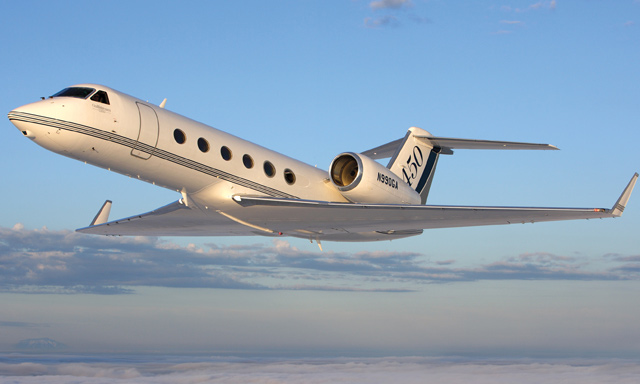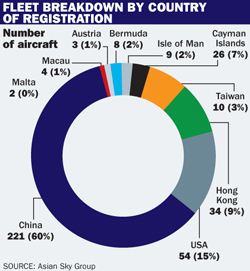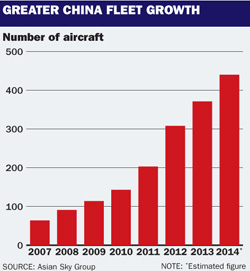The business aircraft manufacturing industry's love affair with China continues to blossom. With its intoxicating mix of economic prosperity and an expanding wealthy personal and corporate customer base, this vast nation is unlikely to lose its appeal any time soon.
From 2007 to 2013, the Greater China business jet fleet increased at a compound annual growth rate of 34% – significantly higher than the global rate of 5%, according to aviation consultancy Asian Sky Group (ASG).
In its latest report on the region’s business aviation sector, the Hong Kong-based company reveals the Greater China business jet fleet swelled by 21% last year to 370 aircraft. This compared with 308 aircraft on 31 December 2012.
Not surprisingly, mainland China accounted for the bulk of the growth in this region – and with an installed base of 248 business jets it is by far the largest market within the territory. Hong Kong follows with 97 aircraft, while Taiwan and Macau have modest and fairly static fleets of only 15 and 11 business jets, respectively.
ASG general manager Jeff Lowe says while 2013's deliveries were impressive, shipments in the first half of the year were uncharacteristically light for mainland China. He attributes the slowdown to the October 2012 handover to a new administration in the People’s Republic of China.
“There was a pregnant pause in the order intake while buyers took stock of the new government,” says Lowe. "The previous administration had gained a reputation for serving its own needs rather than those of the people. The new government took a completely different stance, wanting to be more frugal and receptive to the needs of the country.
“Suddenly, business jet users didn’t want to run foul of the mood in Beijing. Orders were postponed, charter usage slowed down and the days of ramp presence and conspicuous consumption disappeared.”
The lull lasted around six months. “The government soon figured out the important role that business jets played in boosting the country’s economy – there is a lot of foreign direct investment in those aircraft, especially long-range business jets,” Lowe admits. Twice as many business jets were delivered during the second half of 2013 than in the first six months.
Gulfstream is the market leader, with nearly 40% of the total inventory. “The large-cabin G550 and G450 are the king and queen of the region’s fleet, with an installed base of 64 and 46 aircraft, respectively – representing 30% of the total fleet,” says Lowe.
Roger Sperry, Gulfstream’s regional senior vice-president, attributes this dominance to Gulfstream’s strategy to penetrate the market early on. “We set up a sales office in China before there was even a market there. We have continued to invest heavily ever since,” he says.
By the end of 2012 Gulfstream had two sales offices and three service centres in Greater China, including a company-owned facility in Beijing which it operates in partnership with HNA Group – owner of the Asia-Pacific’s largest business aircraft operator, Deer Jet.

Gulfstream is currently the market leader in China
Gulfstream
Sperry admits the cachet of the Gulfstream brand has been a key factor in its success. “Six years ago we only had 13 aircraft in Greater China. By the end of 2013 this number had climbed to 142 – with the bulk of deliveries coming over the last two years,” he says.
The long-range capacity of Gulfstream's top-end business jets has also been instrumental in its success. Sperry says five G650s have been delivered to customers in the Asia-Pacific. Although he will not disclose if any of these ultra-long-range types are Greater China-based, he does admit the region accounts for the largest share of its Asia-Pacific orderbook.
Such is China’s appetite for top-end business jets that the sector saw a 31% increase in its fleet last year, from 109 aircraft to 255 ultra-long-range, super-large and large-cabin aircraft – around 70% of the total fleet, according to ASG. It is no surprise therefore that large-cabin, long-range aircraft manufacturers Bombardier and Dassault have each successfully captured around 30% of the region’s business jet fleet. In fact, China’s Dassault Falcon tally saw a 60% hike in 2013, following the delivery of 15 aircraft into the region, including 11 7X trijets, ASG says.
“Greater China’s craving for these top-of-the-range jets is not surprising, given the region’s rising number of high net worth individuals, increasing corporate profits and its increasing use of business jets as a tool to support corporate international growth and integration,” says Lowe.
However, smaller business jets are now making their mark in China, as buyers are increasingly adopting a more objective and mature approach to aircraft purchases.
“Take a company for example. The first aircraft – the flagship – is purchased by the chairman partly as a business tool and partly for pleasure. He realises how invaluable the corporate jet is to his productivity and introduces another aircraft to the fleet – usually a smaller cabin jet – to increase the efficiencies of his senior executives,” says Lowe.
This view is echoed by Zhang Peng, vice-president of the Asia-Pacific’s largest business aircraft operator and services provider, Deer Jet. “Tastes and requirements are changing,” he says.
The Beijing-headquartered company – one of 46 business aircraft operators in Greater China – has a fleet of 70 mainly high-end jets, but is witnessing a shift in demand to more mission-specific aircraft.
“Customers are becoming more educated, more mature. Rather than using a large-cabin aircraft for their short domestic routes, they are turning to smaller aircraft to serve their needs. It makes more sense,” says Peng.
Deer Jet began operations 19 years ago with a single Bombardier Learjet. Its sister company Hong Kong Jet operates a fleet of 13 business jets.
Based on optimistic projections for business aviation in Greater China, the company expects to add another 28 aircraft from across the spectrum to both business units by the end of the year.
“Chinese GDP is strong and steady. Given this economic situation the wealthy base of users will continue to grow and the market will continue to mature,” Peng adds.
Cessna, meanwhile, is hoping to benefit from this impartial approach to business jet usage. The US airframer – which currently has 7% of the market share – has formed a joint venture with China Aviation Industry General Aircraft Company (CAIGA) to build its 208 Caravan and Citation XLS+ in the cities of Shijiazhuang and Zhuhai, respectively, for Chinese buyers.
Deliveries of the Caravan single-engined turboprop have already started, and the first super-light XLS+ is scheduled for delivery before the end of the year. Bill Schultz, Cessna’s senior vice-president of business development for China, admits it has been a challenge selling the airframer's largely midsize and light cabin inventory in a region so heavily biased towards high-end jets. “The market is now maturing,” he says. “The super-light sector will be popular in China. It offers a similar standard of luxury as the large-cabin jets, but at a size and economy that makes sense for the mission. Stay tuned. It’s coming.”
The sophistication of business aircraft users is also manifesting itself in the growing used aircraft fleet. “There was a time when customers only bought new aircraft. There was a cultural stigma in having someone’s hand-me-down,” says Jahid Fazal-Kharim, co-founder of international aircraft brokerage Jetcraft. “Of course there will always be people who will only buy new. That will never change, but other customers are becoming smarter. They are now seeing the value in preowned aircraft,” he adds.
ASG supports this claim. “Preowned aircraft accounted for 47% of deliveries to Greater China in 2013, clearly demonstrating the increasing acceptance of purchasing used types,” it says.
In some cases the decision to purchase a second-hand aircraft is driven by necessity. “Some aircraft, such as the G650, have incredibly long lead times, so a preowned aircraft – a G550, for example – will be acquired to fill the gap until the new aircraft is delivered,” says Fazal-Kharim.
The used aircraft purchased are typically less than five years old, with low hours. “They still look and feel new. It’s difficult to sell anything over 10 years of age or [that] has flown more than 6,000h,” he continues.
ASG’s data supports Fazal-Kharim. In 2013, 40% of the 45 business jets removed from the Greater China fleet were types that are no longer in production, such as older Citation jets, Hawkers and Gulfstream G280s.
For Lowe, the local buyers are simply getting “savvy”. “They are beginning to understand the market dynamics, and see a lot more value in that business jet purchase,” he says.
While owners and operators are becoming increasingly enlightened by the flexibility and convenience of business aircraft, the lack of infrastructure throughout Greater China to support the expanding fleet remains a major obstacle.
A number of factors are impeding the growth of business aviation, says Lowe – not least the restrictions imposed on operators of foreign-registered aircraft, which make up 40% of the Greater China fleet.



“They face a different set of rules to Chinese [B-registered] aircraft, such as non-direct routings, fewer landing slots, access to fewer airports and higher navigation, landing and ground services charges. Foreign operators are also charged a $1,400 fee by the Civil Aviation Authority of China [CAAC] to process flight permits, and on top of this a compulsory compensation charge of $3,000 is also levied,” says Lowe.
The cost of importing business jets is also high, as government taxes add 22% to an aircraft’s price tag. “A hefty levy on a $65 million business jet,” adds Lowe.
The CAAC also imposes strict regulatory requirements on companies applying for an Air Operator Certificate. “China is very safety conscious. It is deliberately keeping the growth of business aviation in check to ensure it is matched with sufficient infrastructure, such as number of airports, fixed-base operations, maintenance, repair and overhaul facilities, air traffic control and other qualified aviation personnel,” says Lowe.
The government has expressed its commitment to develop business aviation and to further ease some of the current barriers, although the process is slower than many would like.
According to ASG, China has 193 civil airports in service, of which 10 were completed in 2013. CAAC plans to have 244 airports in service by 2020. “Change won’t happen overnight,” Lowe says. “But when the government sets their mind to something, you can be confident it will be done.”
Such reassurances have provided a huge boost to the business aviation industry, which believes there is still huge untapped demand for executive aircraft in this vast region. “China holds nearly 20% of the world’s population, 7% of the world’s billionaires and a 13% wealth annual growth rate, yet it holds less than 2% of the world’s business jets,” says Lowe.
Meanwhile, as China's business aviation market continues to develop and mature, the fleet is set for another significant hike this year, according to ASG. “We expect the installed base to grow by nearly 25% in 2014, reaching a total of 440 aircraft by the end of the year,” it says.
Source: FlightGlobal.com



















